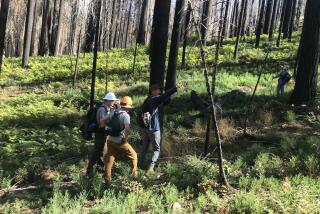Scientists call for more controlled burns in West’s forests

Some of the West’s leading fire scientists are calling for the increased use of managed burns to reduce fuel levels in the region’s forests, warning that climate change is leaving them more vulnerable to large, high-severity wildfires.
In a paper published Friday in the journal Science, seven fire and forest ecologists say the rate of fuel reduction and restoration treatments is far below what is needed to help sustain forest landscapes in an era of rising temperatures and increased drought.
“Fire policy that focuses on suppression only delays the inevitable, promising more dangerous and destructive future forest fires,” wrote the authors, who include Scott Stephens of UC Berkeley, James Agee of the University of Washington, William Romme of Colorado State University and Thomas Swetnam of the University of Arizona.
The authors also made a couple of suggestions that are bound to be more controversial than stepping up managed fire rates.
Some forest lands may be so fire-prone, they wrote, “that building should be prevented, discouraged or removed” through regulation, insurance rates or tax incentives.
They also said significantly more federal money for restoration work could be available if state and local authorities picked up more of the firefighting tab in wildland areas bordering development.
In ponderosa pine and mixed-conifer forests that are adapted to frequent wildfires that burn at low and moderate severity, Stephens said the past century of fire suppression and logging has set the stage for more damaging blazes.
Timber harvest removed most of the largest, fire-resistant trees, while the government’s anti-fire policies promoted dense regrowth and fuel buildup. Now rising temperatures are lengthening the fire season.
“Those forests are so vulnerable,” said Stephens, the paper’s lead author. A key concern is that more severe wildfires in a warmer, drier climate can kill such large patches of conifers that the tree seed bank is lost, thwarting forest regeneration and leading to permanent conversion to shrub fields.
Land managers need to conduct widespread prescribed burns and manage wildfires to reduce forest fuel loads, the authors said.
National parks and a few national forests with huge, remote wilderness areas in Arizona and Idaho have done that. But in many California forests, large-scale managed burn programs have been hindered by air quality regulations and concerns about endangering neighboring rural communities.
If it’s not possible to conduct extensive managed burns, then mechanical thinning of smaller, dense tree growth can help, Stephens said. “This is not,” he emphasized, “cut the big trees.”
The still-smoldering Rim Fire in the Stanislaus National Forest and Yosemite National Park is an example of the kind of fire the authors are concerned about. The largest wildfire to burn in the Sierra Nevada in more than a century of record keeping, the Rim killed big forest patches thousands of acres in size.
Stephens, who conducts research on plots in the Stanislaus, recently returned to a spot where he had earlier come across towering pines and incense cedar several hundred years old. He wanted to see whether the big trees had survived the Rim’s flames.
“I got to the exact plot,” Stephens said. “Unfortunately all the trees died. It was really a kind of sad day.”







